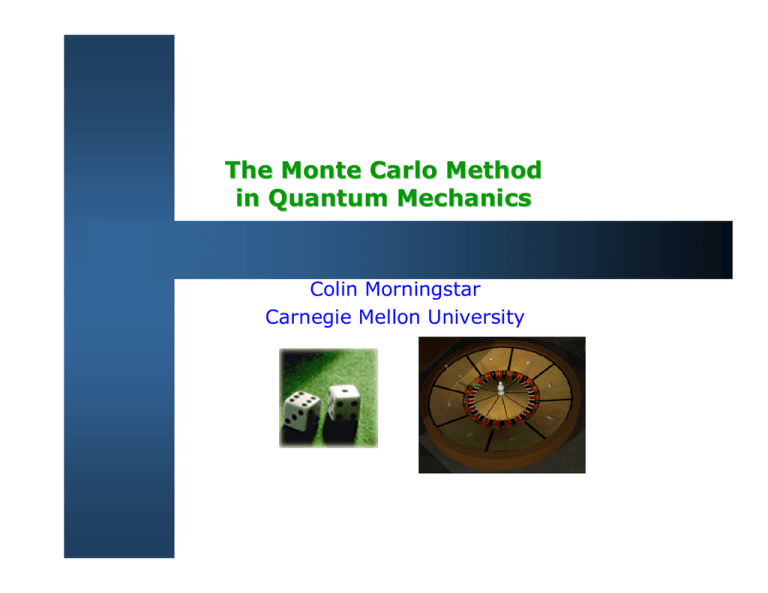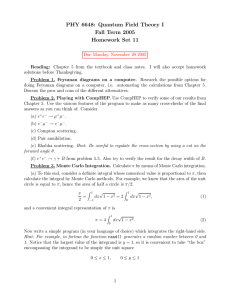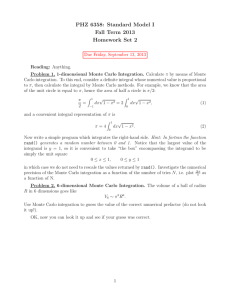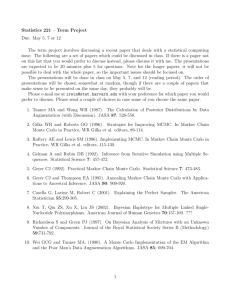The Monte Carlo Method in Quantum Mechanics Colin Morningstar Carnegie Mellon University
advertisement

The Monte Carlo Method in Quantum Mechanics Colin Morningstar Carnegie Mellon University Overview will present a detailed description of a Monte Carlo calculation of a simple quantum mechanical system ¾ the 1-dim simple harmonic oscillator you should be able to do the calculation after this talk! ¾ that’s how easy it is outline: ¾ different view of quantum mechanics Æ path integrals ¾ simple Monte Carlo integration ¾ importance sampling using Markov chains ¾ lattice quantum chromodynamics (QCD) April 20, 2004 Monte Carlo methods 2 Transition amplitudes in quantum mechanics key quantity in quantum mechanics Æ transition amplitude is the probability amplitude for a particle to go from a point at time to the point and time in this talk, shall work in the Heisenberg picture ¾ state vectors are stationary ¾ operators and their eigenvectors evolve with time ¾ shift Hamiltonian so ground state energies are zero April 20, 2004 Monte Carlo methods 3 Vacuum saturation take and in the limit inserting a complete set of energy eigenstates and using assuming nondegenerate vacuum possibility of probing ground state (vacuum) properties April 20, 2004 Monte Carlo methods 4 Vacuum expectation values now apply limit amplitude hence, vacuum expectation values from result generalizes to higher products of position operator April 20, 2004 to more complicated Monte Carlo methods 5 Observables from correlation functions all observables can be extracted from the correlation functions (vacuum expectation values) example: energies of the stationary states similarly for more complicated correlation functions but difficult to extract energies from above oscillatory functions Æ much easier if we had decaying exponentials April 20, 2004 Monte Carlo methods 6 The imaginary time formalism can get decaying exponentials if we rotate from the real to the imaginary axis in time (Wick rotation) later, we will see that this imaginary time formalism provides another important advantage for Monte Carlo applications April 20, 2004 Monte Carlo methods 7 Quantum mechanics and path integrals in the 1940’s, Feynman developed an alternative formulation of quantum mechanics (his Ph.D. thesis) ¾ Richard Feynman, Rev Mod Phys 20, 367 (1948) quantum mechanical law of motion: ¾ probability amplitude from sum over histories all paths contribute to the probability amplitude, but with different phases determined by the action classical limit: when small changes in path yield changes in action large compared to , phases cancel out and path of least action dominates sum over histories April 20, 2004 Monte Carlo methods 8 Defining the path integral action = time integral of Lagrangian (kinetic – potential energy) divide time into steps of width ε where path integral is defined as where A is a normalization factor depending on ε April 20, 2004 Monte Carlo methods 9 The simple harmonic oscillator kinetic and potential energy of a simple harmonic oscillator of mass and frequency action is given by classical equations of motion value of action for the classical path to calculate path integral, write path as deviation from classical path April 20, 2004 Monte Carlo methods 10 Path integral of simple harmonic oscillator amplitude can then be written as partition time into discrete steps of length midpoint prescription April 20, 2004 Monte Carlo methods and use 11 Gaussian integration a multivariate Gaussian integral remains where is a symmetric matrix Gaussian integrals are easily evaluated April 20, 2004 Monte Carlo methods 12 Amplitude for simple harmonic oscillator using a few tricks final result for the path integral April 20, 2004 Monte Carlo methods 13 Evolution of Gaussian wave packet for initial wave packet at time probability amplitude at later time final result for probability dist.: Gaussian with width s new width given by April 20, 2004 Monte Carlo methods with probability dist. 14 Visualization time evolution of a Gaussian wave packet for a simple harmonic oscillator mass m=1g/mol= 1.66×10-27 kg ω=3×1014 radians/sec initial wave packet: center at 0.5 au RMS spread 0.14 au 1 au (atomic unit) = 0.529 angstrom probability distribution shown (in inverse a.u.) completely calculated using path integrals Æ did not use Schrodinger equation April 20, 2004 Monte Carlo methods 15 Other probability amplitudes so path integrals give us simple transition amplitudes but this important result generalizes to more complicated amplitudes for April 20, 2004 Monte Carlo methods 16 Path integrals in imaginary time in the imaginary time formalism, paths contribute to sum over histories with real exponential weights (not phases) classical path gets highest weighting note that weights are real and positive since action is real ¾ this fact will be crucial for the Monte Carlo method April 20, 2004 Monte Carlo methods 17 Vacuum expectation values from path integrals obtain correlation functions (vacuum expectation values) from ratios of path integrals generalizes to more complicated correlation functions ¾ any correlation function can be computed using path integrals April 20, 2004 Monte Carlo methods 18 Examples for the simple harmonic oscillator evaluating path integrals as before, the following correlation functions can be obtained comparison with spectral representation tells us April 20, 2004 Monte Carlo methods 19 Another example in SHO excite vacuum with compare with spectral representation at large time separations interpretation: April 20, 2004 operator Monte Carlo methods 20 One last example in SHO to determine expectation value of state in first-excited compare with spectral interpretation at large times since by inspection and using previously derived results April 20, 2004 Monte Carlo methods 21 Pause for reflection observables in quantum mechanics can be extracted from the correlation functions (vacuum expectation values) imaginary time formalism is a great trick for assisting in such extractions correlation functions can be computed via path integrals April 20, 2004 Monte Carlo methods 22 The die is cast? in rare situations, the path integrals can be computed exactly ¾ simple harmonic oscillator, free particle sometimes the action can be written describes the free motion of the particles ¾ path integrals using are Gaussian and can be exactly computed ¾ describes the interaction of the particles, but the coupling is small ¾ compute in perturbation theory as expansion in however, if interactions are not weak ¾ usually must resort to Monte Carlo methods ¾ – for example, quantum chromodynamics (QCD) April 20, 2004 Monte Carlo methods 23 Simple Monte Carlo integration basic theorem of Monte Carlo integration where are N points chosen independently and at random with uniform probability distribution throughout D-dimensional volume V justified by the central limit theorem in the limit , MC estimate tends to normal distribution, uncertainty tends to standard deviation April 20, 2004 Monte Carlo methods 24 Pseudorandom number generators MC integration requires random numbers but computers are deterministic!! clever algorithms can produce sequences of numbers which appear to be random (pseudorandom) ¾ uniform deviates between 0 and 1 example: the Mersenne twister ¾ http://www.math.sci.hiroshima-u.ac.jp/~m-mat/MT/emt.html currently holds the record for longest period 219937-1 ¾ very fast, passes all standard tests (Diehard) for good RNG devising good RNG’s is a science in itself ¾ most utilize modulus function, bit shifting, shuffling ¾ April 20, 2004 Monte Carlo methods 25 One-dimensional example simple example plot of integrand and some Monte Carlo estimates not efficient for 1-dim integrals! April 20, 2004 Monte Carlo methods 26 Importance sampling importance sampling can greatly improve efficiency of Monte Carlo integration ¾ recall simple integration chosen with uniform probability between 0 and 1 ¾ choose weighting function as close as possible to a constant so is where now chosen with probability density but how do we choose for multi-dimensional complicated integral? April 20, 2004 Monte Carlo methods 27 Markov chains use the elements of a Markov chain generated by a Markov process for our importance sampling!! sequence of configurations generated one after another using transition probability satisfying ¾ strong ergodicity (usually only need weak version) ¾ normalization ¾ stable equilibrium (fixed point) starting with any configuration , will eventually generate configurations with probability distribution April 20, 2004 Monte Carlo methods 28 Detailed balance crucial observation: ¾ last condition holds if transition probability satisfies detailed balance: for every pair and for our path integrals, we need to generate paths with probability distribution ¾ in imaginary time formalism, path integral weight is real and positive Æ probability interpretation for Monte Carlo April 20, 2004 Monte Carlo methods 29 What’s the catch? Monte Carlo estimates require statistically independent random configurations, but configurations generated by a Markov process do depend on previous elements in chain ¾ this dependence is known as autocorrelation this autocorrelation can actually be measured! ¾ for any observable (integrand) , the autocorrelation can be defined by i refers to sequence in the Markov chain highly correlated Æ value near 1 ¾ independent Æ value near 0 dependence decreases as distance between elements increases in the chain ¾ do not use every element in chain for “measurements” ¾ skip some number of elements between measurements ¾ April 20, 2004 Monte Carlo methods 30 The Metropolis algorithm one of the simplest Markov chain updating algorithms is the Metropolis method ¾ for current configuration , propose a new configuration with some transition probability satisfying the microreversibility requirement ¾ compute the change in the action ¾ accept the new configuration with probability this simple algorithm satisfies detailed balance useful for local updating so changes to action are small probability normalization never enters in the calculation! April 20, 2004 Monte Carlo methods 31 Discretization of SHO action action of harmonic oscillator (imaginary time formalism) discretize time for Monte Carlo evaluation choose so discretization errors sufficiently small introduce dimensionless parameters April 20, 2004 Monte Carlo methods 32 Discretization of action (continued) a few more manipulations produce first constant is irrelevant (can be set to zero), then one last rescaling final result for action April 20, 2004 Monte Carlo methods 33 Metropolis updating of path to update location (at a single time) ¾ propose random shift with uniform prob. ¾ calculate change to the action ¾ ¾ accept rule of thumb: fix with probability for about 50% acceptance rate – lower rate = wasting too much time with rejections – higher rate = moving through phase space too slowly repeat for each for (this is called one sweep) repeat for certain number of sweeps ¾ until autocorrelations sufficiently small April 20, 2004 Monte Carlo methods 34 Actual C++ code Here is the actual C++ code which does the updating April 20, 2004 Monte Carlo methods 35 Simulation guidelines to start Markov chain ¾ choose a random path (hot start) ¾ or choose (cold start) ¾ update times until fixed point of chain achieved (thermalization) Æ check some simple observable once thermalized, begin “measurements” must choose ¾ so discretization errors sufficiently small ¾ for adequate acceptance rate ¾ for sufficiently small autocorrelations ¾ for desired precision of results April 20, 2004 Monte Carlo methods 36 Path animation animation of first 100 time slices of April 20, 2004 Monte Carlo methods path 37 Acceptance rate, autocorrelations choose choose April 20, 2004 so acceptance rate near 0.5 so autocorrelations near 0.1 Monte Carlo methods 38 Correlation function comparison of Monte Carlo estimates with exact results •exact result shown as curve •Monte Carlo estimates shown by circles (statistical uncertainties too small to see) April 20, 2004 Monte Carlo methods 39 Lattice Quantum ChromoDynamics hypercubic space-time lattice quarks reside on sites, gluons on links between sites for gluons, 8 dimensional integral on each link path integral has dimension ¾ 10.6 million for 244 more sophisticated updating algorithms systematic errors ¾ discretization ¾ finite volume quarks gluons April 20, 2004 Monte Carlo methods 40 Yang-Mills SU(3) Glueball Spectrum gluons can bind to form glueballs C. Morningstar and M. Peardon, ¾ e.m. analogue: massive Phys. Rev. D 60, 034509 (1999) globules of pure light! states labeled by J PC scale set by r0−1 = 410(20) MeV computed using same techniques as for SHO ¾ 24×24 correlation matrices in each symmetry channel spin identification April 20, 2004 Monte Carlo methods 41 Light hadron spectrum (without quark loops) CP-PACS collab. (Japan) Phys Rev Lett 84, 238 (2000) April 20, 2004 Monte Carlo methods 42 Conclusion observables in quantum mechanical systems can be extracted from the correlation functions of the theory correlation functions can be computed using path integrals path integrals in the imaginary time formalism can be evaluated using the Monte Carlo method ¾ importance sampling from Markov chains the Metropolis method was applied to the 1-dimensional simple harmonic oscillator April 20, 2004 Monte Carlo methods 43






